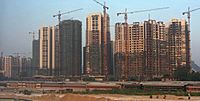
Photo from wikipedia
New urbanization is the fundamental approach to achieve the healthy, stable, and sustainable development of the Chinese economic society. It is also the basic outlet to eliminate the “dual economic… Click to show full abstract
New urbanization is the fundamental approach to achieve the healthy, stable, and sustainable development of the Chinese economic society. It is also the basic outlet to eliminate the “dual economic structure” in urban and rural areas. Based on the connotation of new urbanization, we constructed an evaluation system using population development, economic development, quality of life, infrastructure, resources and environment, and urban and rural harmonious development. The entropy and weighted summation methods were used to measure the level of new urbanization for 11 provincial capital cities from 2005 to 2018, and policy implications were analyzed correspondingly. The results show that there are significant differences in the development levels of new urbanization in these cities, with infrastructure construction being the primary driver. These developments have placed the economy and environment under great pressure. The quality of urban life and the level of infrastructure construction need to be improved because of the expanding economic gap between urban and rural areas. These cities with poor internal coordination also have apparent differences amongst individual factors. Overall, the policies on these factors play a positive role in the process of new urbanization. In the future, provincial capital cities need to consider the weak links and provide more focus on employment and education.
Journal Title: PLoS ONE
Year Published: 2020
Link to full text (if available)
Share on Social Media: Sign Up to like & get
recommendations!